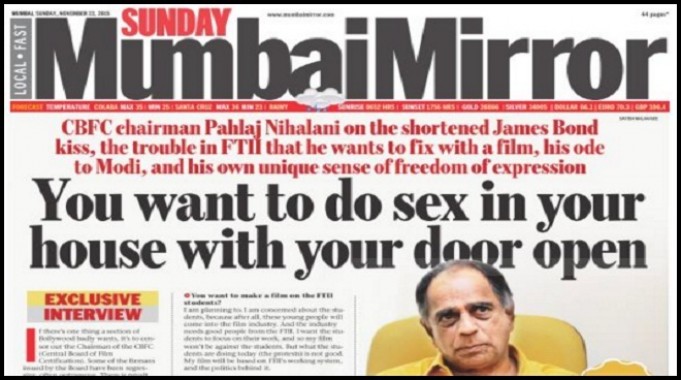Bias: the new norm
“If there’s one thing a section of Bollywood badly wants, it’s to censor out the Chairman of the Central Board of Film Certification. Some of the firmans issued by the Board have been regressive, often outrageous.”
That’s a quote from an opinion piece on the Censor Board, right? Wrong. This is an introduction to a front page interview of the Censor Board chief Pahlaj Nihalani in the tabloid, Sunday Mumbai Mirror, dated November 22, 2015.
Wait, there’s more. “There is a revolt brewing within,” says the introduction, without any substantiation anywhere in the article. “And there are allegations that boss man Pahlaj Nihalani is a stooge of the current central government.”
Allegations? Stooge? Is the current government another Dawood Ibrahim and is Nihalani a plant inside Censor Board of the country? Apart from the obvious coarseness of the language, this is simple finger pointing unsupported by facts and based on an inherent dislike of the Censor Board chief and the government.
It’s bad journalism. It is personal opinion masquerading as reporting. The use of the word ‘outrageous’ is not attributed to anyone and the reference to a “section of Bollywood” does not even contain a few names. And if there is indeed a revolt brewing, surely it needs to be spelt out instead of merely mentioned in passing.
The introduction goes on to tell us: “Most of the comments one reads about his work aren’t flattering.” The connection between the quality of Nihalani’s work and his supposed itch to censor others’ films is unclear unless the interviewer is saying that, only if you have an impressive body of work behind you can you be allowed to do the job. If the comment is the interviewer’s way of telling us that Nihalani is not suitable for the job, this is the wrong place.
Before my criticism is misconstrued as a defence of Nihalani, let me hasten to say it’s not. It could be that there is a revolt brewing in Bollywood; it could be that the board’s decisions are regressive; and it could be that he is not the man for the job. But the way he is being projected in this single paragraph hurts journalism more than it hurts him.
Consider an alternative introduction which said: “Of late, the Censor Board’s decisions have been criticized by some in Bollywood such as A,B,C. Nihalani’s job as Censor Board chief has come under fire because of so-and-so reason”. And then, nuggets from the interview. Briefly, and without wasting words, you are making the relevant points without forcing a point of view down readers’ throats.
It can be argued that the Mumbai Mirror is a tabloid and therefore what can you expect? But tabloids have some norms too, however lax, and even they cannot pass off sneering as informed comment. Comment pieces, meant for the edit and op-ed pages, are the only place in a newspaper open to opinion. Even here, sweeping opinion or any writing that is not backed up by informed argument is taboo. At least, this is what some of us were taught 25 years ago.
Instead, without most of us noticing and without so much as a ‘should I?’, we have segued from presenting information to readers and letting them judge for themselves to the current phase where we tell them what to think. The introduction I have highlighted points to a general trend in Indian journalism where facts are given the go-by and personal views are almost compulsively declared.
The lead stories on the front pages of any leading newspaper are inevitably couched in jargon. The questions that are going to crop up in a reader’s mind are not answered. There is a story on India’s water shortage in a daily which tells us about TMC but not what it stands for. There is a reference to some complex taxation in another newspaper but without any background information and with no explanation about the significance of the story. There is an OROP story which rants away but refuses to flesh out the acronym.
If you are a new reader or have been away from the country, expect to be befuddled rather than informed by the newspapers.
When, why and how did this happen? All blame will be squarely laid at the doors of television and the news websites, but did they follow you or did you follow them? This is not just dilution of standards but a dangerous practice. A group of like-minded journalists with a point of view to project can influence the way a large chunk of readers view an event or a person or a piece of news. Matters have come to such a pass that, if discerning journalists refuse to go with the flow, they will lose out on attractive assignments.
But one can’t help asking: if readers are smart enough to divine all the missing information in a story, can’t they be trusted to form their own opinion without having it formed for them?







